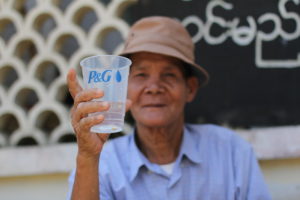
A North Okkalapa Township resident drinks water that has just been made potable by dissolving a Procter and Gamble water purification packet. In Burma USAID and P&G partner to provide clean drinking water and promote sanitation practices for some of the country’s most vulnerable. / Photo by Kelly Ramundo, USAID
Consumer purchases of toilet paper and cleaning supplies drove Procter & Gamble annual sales up the most since 2006. Sharon Terlep reports for The Wall Street Journal:
Procter & Gamble Co., PG 0.34% maker of household staples from Tide detergent to Charmin toilet paper, posted its strongest annual sales gain since 2006 as the pandemic kept the world’s consumers at home and vigilant about cleaning.
Demand in the U.S. for cleaning and paper products continued to surge through the spring and early summer, while the reopening of China, P&G’s second-biggest market, drove sales there. P&G executives said the company’s efforts in recent years to overhaul itself by shedding weaker brands and streamlining what they described as an often-suffocating bureaucracy are paying off at a time of crisis.
The Cincinnati company’s organic sales were up 6% for the fiscal year ended June 30. For the latest quarter, organic sales also rose 6%.
P&G predicted more modest growth of 2% to 4% for the current fiscal year, citing high uncertainty around the global economy, especially in developing countries, and fallout from the new coronavirus.
“On the whole, with health, hygiene and cleaning, consumers’ needs have changed forever,” Chief Financial Officer Jon Moeller said. “Maybe not to the degree that’s happened recently. But it’s hard to imagine we’ll snap back to the old world.”
The strongest growth was in P&G’s fabric and home care unit, which posted a 14% sales gain, its highest ever. The unit’s brands include Tide along with Mr. Clean, Dawn dish soap and Cascade dishwasher detergent.
China sales recovered in recent months after sliding at the start of the year, when the country shut down in an effort to contain the virus. Closed factories, roads and stores stymied production and kept Chinese consumers from buying.
P&G has yet to show signs of being negatively affected by the recession, as consumers remain willing to pay higher prices for its products. A question facing the company, given that its products are generally more expensive than rival brands, is whether it would fare better in an economic downturn than it did during the last recession, when sales growth plunged to anemic levels and took a decade to recover.




